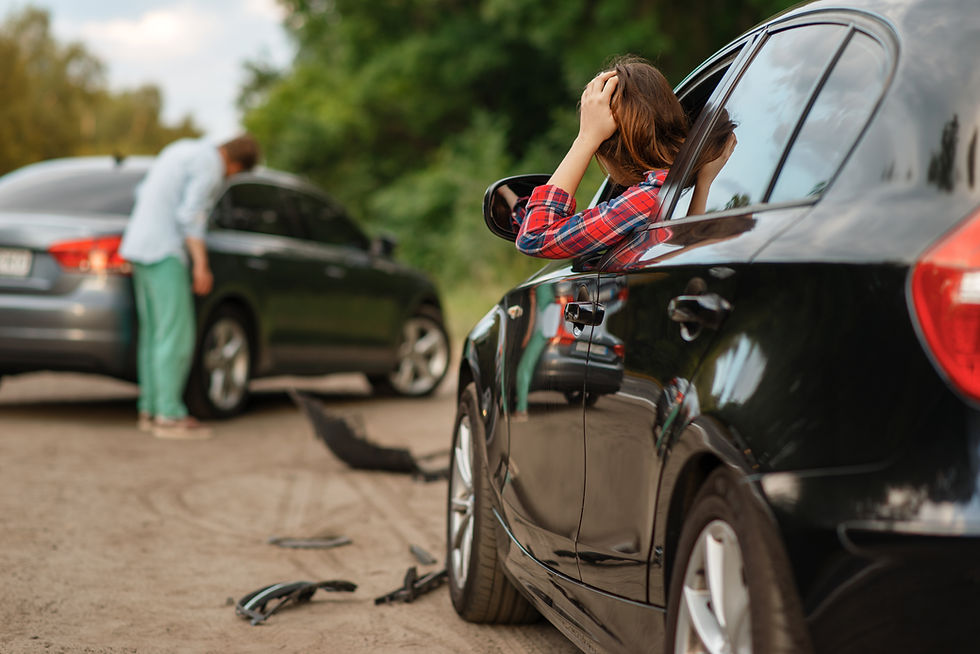The "Sudden Emergency" Defense in Texas Car Accidents
- Emily Geisler
- Oct 8
- 3 min read

The "Sudden Emergency" Defense in Texas Car Accidents
How to Fight Back Against This Common Legal Tactic in a Crash
Imagine this: You’ve been injured in a car accident in Northwest Harris County. Liability is clear. The other driver ran a stop sign, or swerved into your lane and hit you head-on. But when you file a claim with the insurance company, they counter with a powerful legal defense: the “Sudden Emergency” Doctrine. It alleges the driver was not negligent because he or she was forced to react instantly to an unexpected, life-threatening event.
While a legitimate defense, the “sudden emergency” doctrine is sometimes misused by insurance companies to deny or short-change you, even when they should be paying fair compensation. If you hear this term, don’t assume your case is over. By knowing the strict requirements of Texas law, your attorney can effectively fight back.
Texas Law on the Sudden Emergency Claim
The Sudden Emergency defense is well-established in Texas case law, and is also codified in the Texas Pattern Jury Charges (PAJ 107.3). The burden is on the defendant (the driver’s insurance company) to prove all four of the following elements of the defense.
1. Unexpected Occurrence:
An emergency situation arose suddenly and unexpectedly, so it was unforeseeable. (A tire blowout, a child darting into the road, or a sudden, first-time medical event such as a heart attack might fit this criterion).
2. Not the Defendant’s Fault:
The emergency was not caused by any prior negligence on the part of the defendant (i.e., they weren’t speeding, tailgating, or driving distracted, which contributed to the emergency).
3. Required Instant Action:
The situation required immediate, reflexive, split-second action with no time to weigh options or deliberate.
4. Reasonable Action:
The defendant took reasonable action, doing what any normally prudent person would have done in the same emergency circumstances.
If the defense cannot prove any one of these four elements by a preponderance of the evidence, then the defense fails and the case proceeds as a normal negligence claim.
Fighting Back Against the “Sudden Emergency” Defense in Harris County
The strategy in these cases is usually two-fold: to prove that the event itself was foreseeable, or to show that the driver’s reaction to the sudden emergency was unreasonable.
1. Foreseeability:
The event was not really “unexpected” or “Sudden”
The strongest argument is often that the event was not actually a “sudden emergency” because it was expected or anticipated.
• Medical Emergencies:
The driver knew about a medical condition (such as severe diabetes or known epilepsy) and either didn’t take his medication that day, or ignored a doctor’s express instruction not to drive. We use subpoenas and other legal tools to uncover these prior medical records and driving records.
• Vehicle Malfunctions:
The tire blowout or brake failure wasn’t really “unexpected” but was caused by the driver’s own negligent maintenance. We subpoena the driver’s maintenance and inspection records. Did a simple, quick check at the gas station or before the trip would have revealed the dangerous condition? Then the defense fails.
• Road Hazards:
Rain, fog, slippery roads, or other weather-related conditions are rarely considered sudden emergencies in Texas. Why? Because a reasonably prudent driver would slow down to compensate for these driving conditions.
2. Unreasonable Reaction to the Sudden Emergency
If the defense can show an emergency was truly sudden (say, a child unexpectedly ran into the road in front of the driver), then the driver still has the burden of proving that his or her actions were reasonable under the circumstances.
Swerving into oncoming traffic to avoid the child, for instance, may be unreasonable if a safer reaction (immediate braking, for instance) was possible. We use accident reconstruction experts to determine how vehicle data, braking distance, and impact angles show that the driver had more time or reacted improperly.
The Two-Year Deadline
Insurance companies like to try this defense early on to delay a claim and to intimidate the accident victim and put them off balance. But don’t let them. The clock is still ticking. For most personal injury claims in Texas, the Statute of Limitations (deadline) is two years from the date of the accident. In serious injury cases, the clock does not start running until the date of maximum medical improvement (MMI) but is still two years from that date.
Contact a car accident attorney if you or a loved one has been seriously injured in a car crash in Hockley, Cypress, or anywhere in Northwest Harris County, and the at-fault driver is claiming a “sudden emergency.” At the Law Office of Shaw Clifford, we have the resources and expertise to dismantle this defense by vigorously investigating the facts and using the Texas law to protect your right to full compensation. Contact us today for a free case evaluation.



Comments